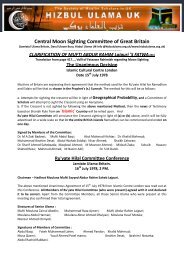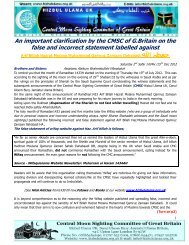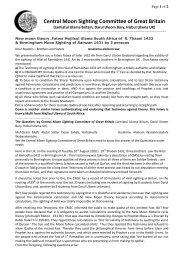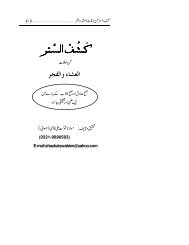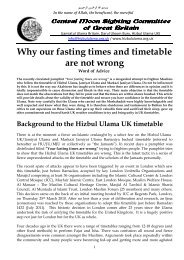article on Fajar and Isha observations by Dr ... - Hizbul Ulama UK
article on Fajar and Isha observations by Dr ... - Hizbul Ulama UK
article on Fajar and Isha observations by Dr ... - Hizbul Ulama UK
Create successful ePaper yourself
Turn your PDF publications into a flip-book with our unique Google optimized e-Paper software.
features of a pers<strong>on</strong> st<strong>and</strong>ing some 10-12 feet away could be recognized. Fajr 3<br />
(Tabayyan) followed 8-10 minutes later when the light spread over the entire eastern<br />
horiz<strong>on</strong> <strong>and</strong> is not tabulated.<br />
In the evening, bright light was quite intense after sunset <strong>and</strong> covered the entire<br />
western horiz<strong>on</strong>. It lost its intensity 20-25 minutes later, <strong>and</strong> narrowed until a yellowish<br />
threadlike streak with a peak at the center remained for the next 12-15.(This is what we<br />
put as <strong>Isha</strong> 1.) Because of lack of moisture <strong>and</strong> dust p<str<strong>on</strong>g>article</str<strong>on</strong>g>s no redness was ever<br />
observed. The yellowish narrow white streak <strong>on</strong> the lowest horiz<strong>on</strong> disappeared<br />
completely at <strong>Isha</strong> 2, making the entire sky dark.<br />
One of us also first observed a very thin Jumada II crescent mo<strong>on</strong> <strong>on</strong> July 7, at<br />
8:47 pm some 12 minutes after the sunset in an extremely clear sky. Others were able to<br />
see it three to four minutes later.<br />
Date Sunrise Fajr1 Fajr 2 Sunset <strong>Isha</strong> 1 <strong>Isha</strong> 2<br />
7/1/05 5:48am 4:54am 5:17am 8:32 9:12pm 9:29pm<br />
7/7/05 5:51 4:56 5:21 8:30 9:11 9:27<br />
7/19/05 5:59 5:02 5:23 8:25 9:08 9:19<br />
Two observers who never participated earlier in naked-eye observati<strong>on</strong>s of the<br />
phenomen<strong>on</strong> observed Fajr 1 some 3-5 minutes later. Similarly, for <strong>Isha</strong> 2, they claimed<br />
the sky was dark a few minutes earlier.<br />
In the last week of the observati<strong>on</strong>al period we also made rough sketches of the sky<br />
brightness at various stages.<br />
C<strong>on</strong>clusi<strong>on</strong>s<br />
Our observati<strong>on</strong>s c<strong>on</strong>firmed that in Medina during the time of the earliest Islamic<br />
community the quantifying process for the prayer schedule was dependent <strong>on</strong><br />
atmospheric c<strong>on</strong>diti<strong>on</strong>s at Fajr <strong>and</strong> ‘Utama for <strong>Isha</strong>.<br />
In Medina, a small desert town, lack of moisture in the atmosphere made twilights<br />
shorter. Hence Fajr prayers were held closer to sunrise <strong>and</strong> <strong>Isha</strong> closer to the sunset. The<br />
Qur’anic use of the two terms <strong>and</strong> practices reported in Ahadith (Afzal et. al 1993) point<br />
in the same directi<strong>on</strong>.<br />
Later, Muslim time-keepers (Muwaqqiteen) in Syria tried to use Greek astr<strong>on</strong>omical<br />
terms for Fajr <strong>and</strong> <strong>Isha</strong>. Ultimately, various Fiqh positi<strong>on</strong>s tied Fajr <strong>and</strong> <strong>Isha</strong> in later half<br />
of the twentieth century to the sun’s depressi<strong>on</strong> in higher latitudes. The variati<strong>on</strong> is the<br />
length of Shafaq (twilight) is enormous from 39 minutes to two <strong>and</strong> half hours in<br />
temperate climates <strong>and</strong> very unusual above 48 degrees latitudes.<br />
A summary of our earlier research <strong>on</strong> the topic of <strong>Isha</strong> <strong>and</strong> Fajr times is reproduced<br />
below. Our observati<strong>on</strong>s at Tracy, California str<strong>on</strong>gly support our c<strong>on</strong>clusi<strong>on</strong>s.<br />
C<strong>on</strong>clusi<strong>on</strong>s







